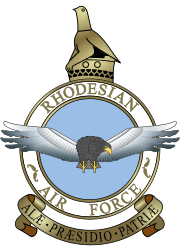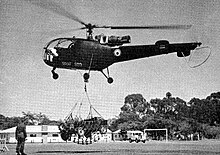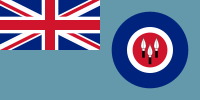
The Air Force of Zimbabwe (AFZ) is the air force of the Zimbabwe Defence Forces. It was known as the Rhodesian Air Force until 1980. The Air Force of Zimbabwe saw service in the Mozambican Civil War in 1985 and the Second Congo War of 1998–2001.
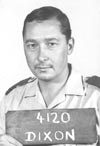
Squadron Leader Christopher John Taylor Dixon D.C.D., also known by his callsign of Green Leader, was a Rhodesian military pilot for the Rhodesian Air Force and was born in Shabani, Southern Rhodesia. He was best known for leading the Rhodesian Operation Gatling bombing raid over Zambia, which later became known as the "Green Leader Raid".

The Zimbabwe National Army (ZNA) is the primary branch of the Zimbabwe Defence Forces responsible for land-oriented military operations. It is the largest service branch under the Zimbabwean Joint Operations Command (JOC). The modern army has its roots in the Rhodesian Army, which was raised between 1963 and 1964 after the breakup of the Federation of Rhodesia and Nyasaland. A Joint High Command created in March 1980 to oversee integration of the formerly belligerent Rhodesian Security Forces, Zimbabwe African National Liberation Army (ZANLA), and the Zimbabwe People's Revolutionary Army (ZIPRA) officially established the Zimbabwe National Army in late 1980, nearly a year after the end of the Rhodesian Bush War.

The Rhodesian African Rifles (RAR) was a regiment of the Rhodesian Army. The ranks of the RAR were recruited from the black African population, although officers were generally from the white population. The regiment was formed in May 1940 in the British colony of Southern Rhodesia.

The 1st Battalion, Rhodesian Light Infantry (1RLI), commonly The Rhodesian Light Infantry (RLI), was a regiment formed in 1961 at Brady Barracks as a light infantry unit within the army of the Federation of Rhodesia and Nyasaland. Barely a year after its creation, it was relocated to Cranborne Barracks (Salisbury) where its headquarters remained for the rest of its existence. The Regiment became part of the Southern Rhodesian Army when the Federation dissolved at the start of 1964 and, later that year, reformed into a commando battalion.

The Rhodesian Special Air Service or Rhodesian SAS was a special forces unit of the Rhodesian Army. It comprised:
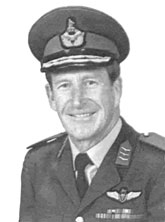
Air Marshal Norman Walsh was a senior officer in the Rhodesian Air Force and the first commander of the Air Force of Zimbabwe.

The Rhodesian Armoured Corps, nicknamed the "Black Devils" — was the only standing armoured battalion of the Rhodesian Security Forces. During World War II, it took part in the Allied Spring 1945 offensive and the Battle of Monte Cassino as part of South Africa's 6th Armoured Division. The unit was among the first to enter a liberated Florence in July 1944. Prior to 1963, its crews were trained in the United Kingdom or Aden Colony and were known as the "Selous Scouts" under the Federation of Rhodesia and Nyasaland. After Rhodesia's Unilateral Declaration of Independence, maintaining the armoured vehicle fleet became a responsibility of the Rhodesian Light Infantry until Major Bruce Rooken-Smith reactivated the former Rhodesian Armoured Car Regiment in 1972. During the Rhodesian Bush War, the regiment fought in several major campaigns and battles, particularly Operation Miracle in September 1979. It was superseded by the new Zimbabwe Armoured Corps between 1980 and 1981.

The Rhodesian Security Forces were the military forces of the Rhodesian government. The Rhodesian Security Forces consisted of a ground force, the Rhodesian Air Force, the British South Africa Police, and various personnel affiliated to the Rhodesian Ministry of Internal Affairs. Despite the impact of economic and diplomatic sanctions, Rhodesia was able to develop and maintain a potent and professional military capability.
Air Marshal Archibald Oliver Garfield Wilson was a Rhodesian fighter pilot who served in the Royal Air Force during World War II. He went on to become a senior commander and then Air Marshal in the Rhodesian Air Force in the 1960s and early 1970s. After retirement, he served two terms in the Rhodesian House of Assembly, in the Zimbabwe-Rhodesian Parliament in 1979, and then in the Zimbabwe Parliament in 1981–1982. He held several cabinet portfolios prior to the Internal Settlement. He resigned in 1982 to emigrate, with his wife Lorna, to Australia's Gold Coast in 1982. He became a citizen of Australia in 1988.

The Rhodesia Regiment (RR) was one of the oldest and largest regiments in the Rhodesian Army. It served on the side of the United Kingdom in the Second Boer War and the First and Second World Wars and served the Republic of Rhodesia in the Rhodesian Bush War.
The 1st Battalion, The Rhodesian Light Infantry, commonly the Rhodesian Light Infantry, served in the Rhodesian Bush War as part of the Rhodesian Security Forces between 1964 and 1979, under the unrecognised government of Rhodesia after its Unilateral Declaration of Independence from Britain on 11 November 1965. Latterly, during the second half of 1979, it fought for Zimbabwe Rhodesia, a reorganised version of Rhodesia under a black majority government which still went unrecognised. After an interim period under British control from December 1979 to April 1980, the RLI briefly remained active within the armed forces of the internationally recognised Republic of Zimbabwe, but did not see action under this government. It laid up its colours on 17 October 1980 and disbanded two weeks later.
Air Marshal Frank Walter Mussell is a retired commander of the Rhodesian Air Force and of the Air Force of Zimbabwe.
William John Harper was a politician, general contractor and Royal Air Force fighter pilot who served as a Cabinet minister in Rhodesia from 1962 to 1968, and signed that country's Unilateral Declaration of Independence (UDI) from Britain in 1965. Born into a prominent Anglo-Indian merchant family in Calcutta, Harper was educated in India and England and joined the RAF in 1937. He served as an officer throughout the Second World War and saw action as one of "The Few" in the Battle of Britain, during which he was wounded in action. Appalled by Britain's granting of independence to India in 1947, he emigrated to Rhodesia on retiring from the Air Force two years later.

Ioannis Agorastos "John" Plagis, DSO, DFC & Bar (1919–1974) was a Southern Rhodesian flying ace in the Royal Air Force (RAF) during the Second World War, noted especially for his part in the defence of Malta during 1942. The son of Greek immigrants, he was accepted by recruiters only after Greece joined the Allies in late 1940. Following spells with No. 65 Squadron and No. 266 (Rhodesia) Squadron, he joined No. 249 Squadron in Malta in March 1942. Flying Spitfire Mk Vs, Plagis was part of the multinational group of Allied pilots that successfully defended the strategically important island against numerically superior Axis forces over the next few months. Flying with No. 185 Squadron from early June, he was withdrawn to England in early July 1942.

Southern Rhodesia, then a self-governing colony of the United Kingdom that is located in the now-independent Zimbabwe, entered World War II along with Britain shortly after the invasion of Poland in 1939. By the war's end, 26,121 Southern Rhodesians of all races had served in the armed forces, 8,390 of them overseas, operating in the European theatre, the Mediterranean and Middle East theatre, East Africa, Burma and elsewhere. The territory's most important contribution to the war is commonly held to be its contribution to the Empire Air Training Scheme (EATS), under which 8,235 British, Commonwealth and Allied airmen were trained in Southern Rhodesian flying schools. The colony's operational casualties numbered 916 killed and 483 wounded of all races.
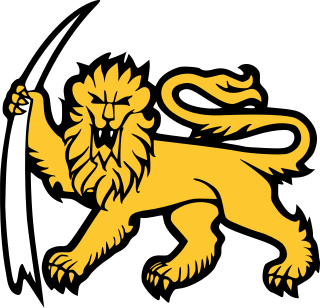
The Lion and Tusk was the main logo of the British South Africa Company (BSAC) and later as a state symbol of Rhodesia. The logo was used following the Company being set up during the scramble for Africa and was used as they governed Rhodesia. Following the company relinquishing control of Northern and Southern Rhodesia, the symbol fell out of favour with the Rhodesian public. However, following the Rhodesian republic being declared in 1970, the Lion and Tusk symbol was adopted as a state symbol to replace the British Empire's Royal crown until the establishment of Zimbabwe in 1980.

The Rhodesian Air Force Ensign was used as the flag of the Rhodesian Air Force. The first flag was created in 1954 under the Federation of Rhodesia and Nyasaland, being updated following Southern Rhodesia exiting the Federation in 1963. It was updated further in 1970 when Rhodesia unilaterally declared themselves a republic.
Lieutenant Colonel John Charles Wyatt Aust, commonly known as Charlie Aust was a Rhodesian military commander. He was born in Enkeldoorn, Southern Rhodesia and was the last commanding officer of the Rhodesian Light Infantry (RLI).

Air Vice-Marshal Harold Hawkins was an Australian-born air force officer and diplomat. He served in the Royal Australian Air Force between 1941 and 1945. He enlisted in what became the Royal Rhodesian Air Force in 1947, and was its commander from 1965 to 1969. Hawkins subsequently became the Rhodesian Accredited Diplomatic Representative to South Africa until 1980.
